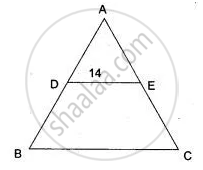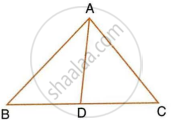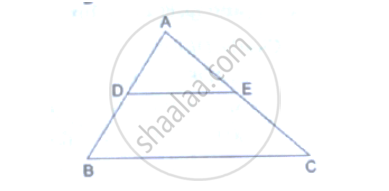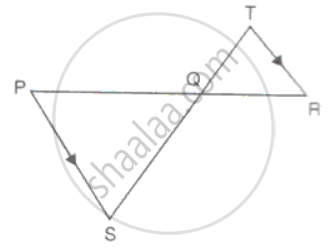Advertisements
Advertisements
प्रश्न
In the adjoining figure. BC is parallel to DE, area of ΔABC = 25 sq cm, area of trapezium BCED = 24 sq cm, DE = 14 cm. Calculate the length of BC.
उत्तर
Given: Area of ΔABC = 25 cm2
Area of trapezium BCED = 24 cm2
and DE = 14 cm
∴ Area of ΔADE = area of ΔABC - area of trap. BCED
= 25 - 24
= 1 cm2
∵ ΔABC ∼ ΔADE
∴ `"Area of (ΔABC)"/"Area of (ΔADE)" = "BC"^2/"DE"^2`
`(25)/(1) = "BC"^2/14^2`
`"BC"/(14) = (5)/(1)`
BC = 5 x 14
= 70 cm.
APPEARS IN
संबंधित प्रश्न
In ΔABC, ∠ABC = ∠DAC, AB = 8 cm, AC = 4 cm and AD = 5 cm.
- Prove that ΔACD is similar to ΔBCA.
- Find BC and CD.
- Find area of ΔACD : area of ΔABC.

ΔABC ~ ΔDEF and their areas are respectively `100cm^2` and `49cm2`. If the altitude of ΔABC is 5cm, find the corresponding altitude of ΔDEF.
In ΔABC, D and E are the midpoints of AB and AC respectively. Find the ratio of the areas of ΔADE and ΔABC.

A line PQ is drawn parallel to the side BC of ΔABC which cuts side AB at P and side AC at Q. If AB = 9.0 cm, CA = 6.0 cm and AQ = 4.2 cm, find the length of AP.
In ΔABC, D and E are the mid-point on AB and AC such that DE || BC.
If AD = 4x - 3, AE = 8x - 7, BD = 3x - 1 and CE = 5x - 3,Find x.
In the figure, PQR is a straight line and PS || RT. If QS = 12cm, QR = 15cm, QT = 10cm and RT = 6cm, find PQ and PS.
ΔXYZ is enlarged to ΔX'Y'Z'. If XY = 12cm, YZ = 8cm and XZ = 14cm and the smallest side of ΔX'Y'Z' is 12cm, find the scale factor and use it to find the length of the other sides of the image ΔX'Y'Z'.
A map is drawn to scale of 1:20000. Find: The area of the lake on the map which has an actual area of 12km2
If figure OPRQ is a square and ∠MLN = 90°. Prove that ∆LOP ~ ∆QMO

If ΔABC ~ ΔLMN and ∠A = 60° then ∠L = ?
